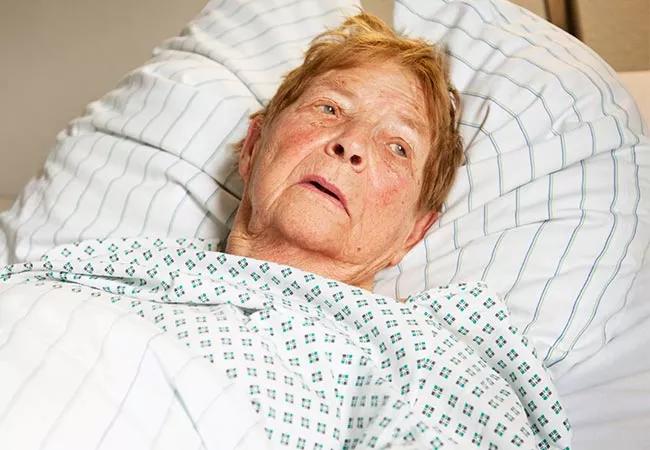
Delirium has been referred to as the “geriatrician’s code blue.” It is a medical emergency that requires prompt recognition and intervention to minimize or prevent serious consequences. It is recognized as a brain dysfunction characterized by an acute and fluctuating disturbance of consciousness with a change in cognition or the development of perceptual disturbances.
Cleveland Clinic is a non-profit academic medical center. Advertising on our site helps support our mission. We do not endorse non-Cleveland Clinic products or services. Policy
It is sometimes associated with hallucinations and hyperactivity, with the patient becoming inaccessible to normal contact. Delirium can be caused by a number of conditions, including infection, drug use, seizures, brain tumor, poisoning, head injury and metabolic disturbances.
Unfortunately, delirium is a grossly unrecognized and poorly managed problem in acute care hospitals across the country. Busy clinical settings, lack of knowledge and training, and the rapid transfer of patients are some of the reasons delirium can be missed, with patient behavior often attributed to depression or a normal progression of aging.
Not only is it distressful for the patient and caregivers, delirium increases morbidity, mortality and neuropsychological impact as well as patient length of stay and patient readmissions.
“We can and must do better,” says Leo Pozuelo, MD, FACP, FAPM, Section Head for Consultation Liaison Psychiatry at Cleveland Clinic and a staff member in the Center for Geriatric Medicine. He believes every healthcare discipline has a role in the prevention, identification and treatment of delirium and an interdisciplinary approach is required.
In 2012, Cleveland Clinic created a multidisciplinary delirium task force to tackle this complex problem at all levels. The idea was that “everyone owns delirium,” and the goal was to take a comprehensive approach to delirium across the health system. The task force wanted to raise awareness, implement regular screenings, and provide easily accessible tools for clinical interventions.
Dr. Pozuelo led the multispecialty delirium task force, which has created a delirium care path and a comprehensive delirium tool kit. The care path rolled out across the system in 2014 after research and pilot tests were completed.
Today the effort focuses on four key areas:
Preventing delirium begins by fully understanding it. In 2014 a full-scale education campaign began for bedside clinicians, nurses and physicians of all levels and inpatient specialties. The task force created a dynamic online learning module with video vignettes as well as an abundance of classes and real-time learning emphasizing risk factors, recognition and strategies for prevention.
Because the prevalence for delirium is so high and so often unrecognized, nurses throughout the Cleveland Clinic health system began screening all adult acute care patients with standardized tools at least once a day. The Confusion Assessment Method for the ICU (CAM-ICU) tool was expanded to all intensive care patients. It is the widely recognized gold standard tool for this environment.
Outside the ICU, the task force looked at several evidence-based tools, with bedside nurses trialing three different screening tools. They eventually decided on the Brief Confusion Assessment Method (bCAM) because they found it to be the easiest to use with the closest relationship to the CAM-ICU tool. Nurses and physicians alike preferred the bCAM.
Beginning in late 2014, the bCAM went live on Cleveland Clinic’s electronic medical record system and nurses began completing it daily. Now all adult patients in ICU and medical/surgical areas are screened on admission, a change in condition or a change in the level of care. To aid in the review of the screens, a delirium accordion report was developed to give clinicians a snapshot view of prior delirium screens, abnormal lab values and high-risk medications.
“Early on, the task force realized the importance of standardizing the management of delirium,” says Dr. Pozuelo. “We were all over the map as to how we treated delirium.”
In any setting, treatment of delirium consists of taking care of the underlying medical condition and removal or discontinuation of the precipitating factors, whether environmental or medication related, he notes.
Through much collaboration among psychiatrists, geriatricians, hospitalists, intensivists, neurologists, nurses and pharmacists, two order sets where developed — one for the ICU patient and one for the non-ICU patient. These order sets give guidance to physicians about diagnostic evaluation and select medications to use to control symptoms of agitation and psychosis.
The order sets limit variation in testing and prescribing, yet allow for flexibility and individualization in a controlled fashion. They also include evidence-based, nonpharmacologic interventions such as uninterrupted sleep, adequate hydration and ambulation.
Delirium has traditionally been considered a short-term, benign and transient cognitive disorder. But we have found that this is not the case. Delirium is a leading cause of preventable conditions in elderly patients who are hospitalized, and patients with delirium fare worse than their counterparts who do not suffer from delirium.
Research tells us that the longer the duration of delirium, the greater the chance for long-term cognitive impairment. This is because delirium itself can cause cognitive decline due to long-term psychological distress and other behavioral issues such as poor nutrition, sleep disturbances and falls.
This has implications in terms of post-discharge follow-up for patients who developed delirium while hospitalized.
Through improved documentation and coordinated care programs, delirium also is being watched more closely during post-acute care. These efforts are gradually changing the culture of Cleveland Clinic to make everyone aware of delirium and individuals at high risk for it.
“Delirium is finally being seen as an acute brain dysfunction with possible long-term consequences,” says Dr. Pozuelo. “Via collaborative efforts at various institutions, we are learning how to better detect, prevent and treat delirium. We owe this to our patients and their families.”
Special thanks to Ronan Factora, MD, and Anne Vanderbilt, MSN, RN, CNS, ANP-BC, from Geriatric Medicine for their contributions to this article.

Social prescribing turns leisure activities into good “medicine”

Study highlights importance of responsive, customized approach

Surrogate decision-making appears to increase risk of serious complications

Geriatric Emergency Needs Assessment

Cleveland Clinic joins Yale in new study

Unique model of care helps optimize medications in high-risk cohort

1-Minute Consult: Updated recommendation reflects reduced incidence of disease

Addressing cognition issues associated with cardiovascular disease